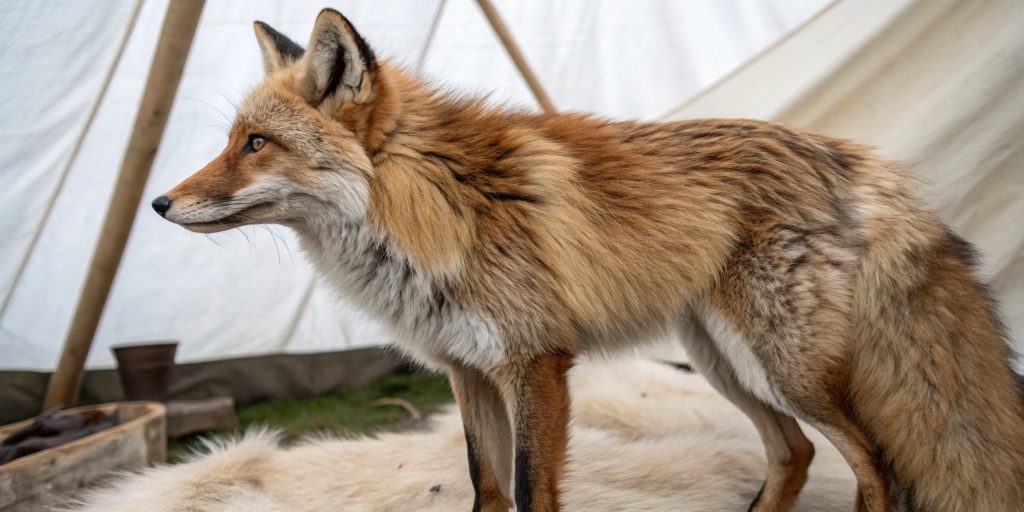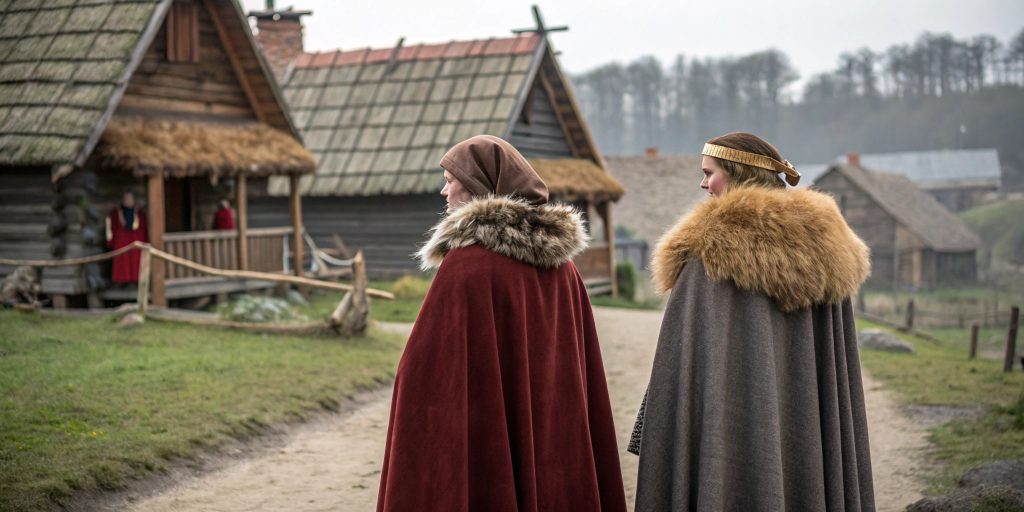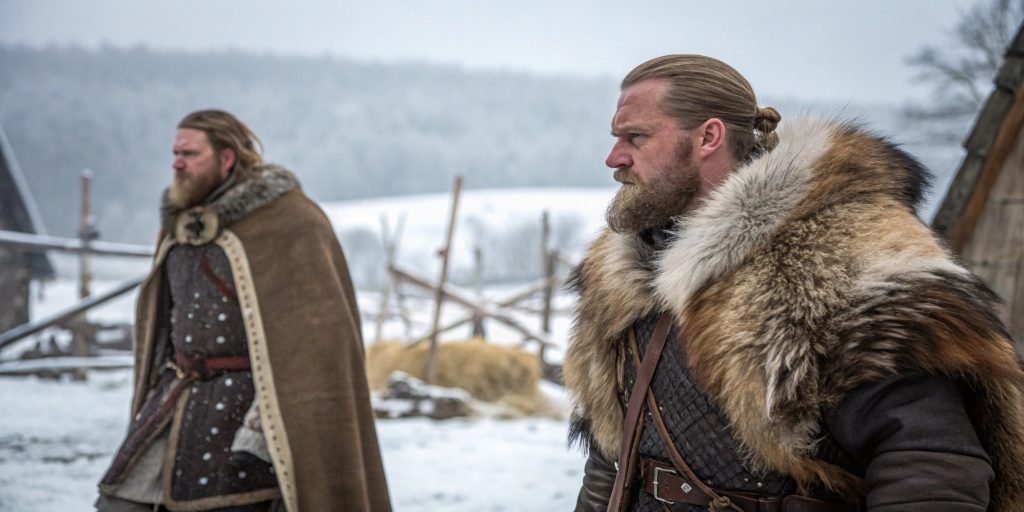Viking Clothing and Jewelry, Vikings
Did Vikings Wear Fox Fur?
The Viking Age lasted from about 793 to 1066 AD. During this time, the Norse people found ways to survive in tough conditions. They used Viking furs to stay warm and safe.
So, did Danish Vikings wear fox fur? Fox fur is soft and keeps warm well. It might have been in their clothes. We’ll examine how fur was important to Vikings and if fox fur was used alongside faux fur options.
The Role of Fur in Viking Culture
Fur was essential in Viking culture. It was not just for keeping warm. For Danish Vikings, fur showed their status and followed social rules.
It showed how wealthy and skilled they were in hunting. Fur was a big part of their lives.
Many furs, like those from foxes, were special. Rich Vikings wore fur mantles made from the best pelts, a practice that has evolved into the use of faux fur today. These showed their wealth and hunting skills.
These clothes were not just for looks. They were also practical. They were key to Viking fashion, frequently incorporated into shawls and belts.
Fur played a big role in daily life and trade, too. Trading furs was key to the Viking economy. It showed how important fur was in their world, symbolizing practicality and barbarian status.
Understanding Viking Furs
Viking furs were key in Norse life for warmth and status. They used different furs based on their needs. Let’s examine the furs they used and why they were important in cold winters.
Types of Fur Used by Vikings
Vikings used various furs for their clothes, including luxurious fur capes and mantles. This was to face harsh weather, where the combination of fur and leather provided essential protection. Here are some common ones:
- Rabbit fur – soft and warm, frequently used in accessories like shawls.
- Sheepskin – durable and insulating, often used to create medieval Viking garments.
- Reindeer – great for cold, icy places
Each fur had its benefits. This showed how clever Vikings were in choosing the right fur for their needs.
Benefits of Using Fur for Clothing
Fur clothing was vital for Vikings. It kept them warm and dry in the cold. Other benefits include:
- Durability – fur lasts long, but faux fur offers a more ethical choice for modern wear.
- Water resistance – some furs keep out moisture
- Natural insulation – wool and fur keep heat in
Wearing fur clothes, like cloaks, helped Vikings stay warm. It also kept their culture alive in harsh conditions, with the use of viking fur cloaks being a notable example.
Did Vikings Wear Fox Fur?
Historians and fans are curious about Vikings wearing fox fur and how it compares to faux fur. Archaeology shows that Vikings used many animal furs, including fox fur, often crafted into shoulder fur. These furs were not just for keeping warm; they also showed a person’s status and way of life.

We know most of Viking furs from old burial sites and settlements. Fox fur was found in many Viking costumes. This shows that fox fur was a key part of Viking fashion, adding elegance and warmth to their clothes.
Vikings chose their clothes for warmth and function. Fox fur was soft and kept them warm, making it great for cloaks and mantles. The patterns in fox fur added beauty, making it a favorite for those who wanted comfort and style.
In summary, fox fur in Viking clothes combines practicality and beauty. It was a key part of their wardrobe, helping them stay warm in Scandinavia.
Viking Furs: Material Choices and Craftsmanship
Viking craftsmanship was all about knowing materials and techniques well. They worked hard to make fur garments that lasted and looked good. They used many animal furs, paying close attention to every step of making clothes for everyday life and war, including adding fur leg designs.
Techniques for Processing Fur
Processing fur was a detailed process for Vikings. They used several important methods to get high-quality fur:
- Tanning: They used animal brains and plant tannins to strengthen fur.
- Cutting: Knowing animal anatomy helped them use fur well and waste less.
- Sewing: Their sewing skills made clothes that fit right and were strong.
Styling Viking Fur Clothing
Styling fur was a way for Vikings to show who they were and what they needed. They made clothes that were both useful and stylish. Some common features included:
- Fur collars: Made clothes warmer and more elegant.
- Capes and mantles kept them warm and showed their status, much like a modern Viking cloak.
- Sewn sheepskin: Added comfort and strength to layered outfits, commonly seen in Viking fur mantles.
The unique cuts and patterns of Viking clothes showed their culture and lifestyle, with many outfits featuring a larp aesthetic. They were made for the active lives of Viking warriors, connecting them to their land and heritage.
Comparing Fox Fur with Other Animal Furs
Fur was key in Viking life, offering protection and status, often seen in garments like the Viking fur mantle. Fox fur was special among the Danes Vikings, usually crafted into luxurious garments like the viking fur collar. Its unique traits show why Vikings chose it for their clothes, including fur and leather combinations.
Characteristics of Fox Fur
Fox fur is known for its special qualities. These include:
- Soft fur: It’s very soft, making it cozy for clothes.
- Warmth: Fox fur keeps you warm, perfect for cold Scandinavia.
- Durable: It’s strong, lasting longer than other furs.
These traits make fox fur great for Viking clothes. It’s both useful and luxurious. Fox fur is richer and warmer than rabbit fur and looks better.
Popular Furs Among the Danes Vikings
The Danes Vikings used many furs for different reasons. These choices showed their status and needs. The most popular furs were:
- Fox fur
- Rabbit fur
- Mink fur
- Beaver fur
Viking warriors wore furs that matched their armor. This made them look better in battle. The choice of fur showed a person’s wealth and status, often highlighted by a viking fur collar. Fur was important in Viking society, showing wealth and power.
The Fashion of the Viking Age
The Viking Age had its fashion trends, which showed how practical and beautiful clothing could be. Vikings used materials like fur, which kept them warm and made their clothes look great.

Fur in Viking Clothing Styles
Fur was key to Viking clothes. They wore fur cloaks over their clothes to stay warm in cold winters, and fur collars were also popular for their luxury and protection.
The mix of fabric and fur made Viking clothes stand out. It added depth and character to their outfits.
- Fur shoulder wraps offered protection while facilitating freedom of movement.
- Viking attire featured intricate designs, showcasing the skills of their craftsmen.
- Accessories like leather bracers complemented the overall outfit, providing style and function.
Viking Warrior Attire and Accessories
Viking warriors wore fur in their military gear. This showed their strength and resilience. Their fur-adorned armor was not just for protection but also for status.
- Fur collars adorned helmets for added style and warmth, like those seen on modern faux fur mantles.
- Leather bracers equipped warriors to defend against attacks while showcasing craftsmanship.
- Utilization of various furs varied according to rank and preference, underlining social status.
Conclusion
Viking furs were key to Viking culture. They kept people warm in cold winters and showed status and identity.
Fur clothing was made with skills like hunting and tailoring. Fox fur was especially valued for its softness and warmth. It showed the wealth and power of Viking society.
Fur clothing showed the richness of Viking culture. It reflected their social levels and lifestyle. Viking furs, like fox fur, made Vikings unique.
The importance of fur goes beyond keeping warm. It’s part of Viking traditions, which show their lasting impact on history, including using faux fur in modern cosplay.

